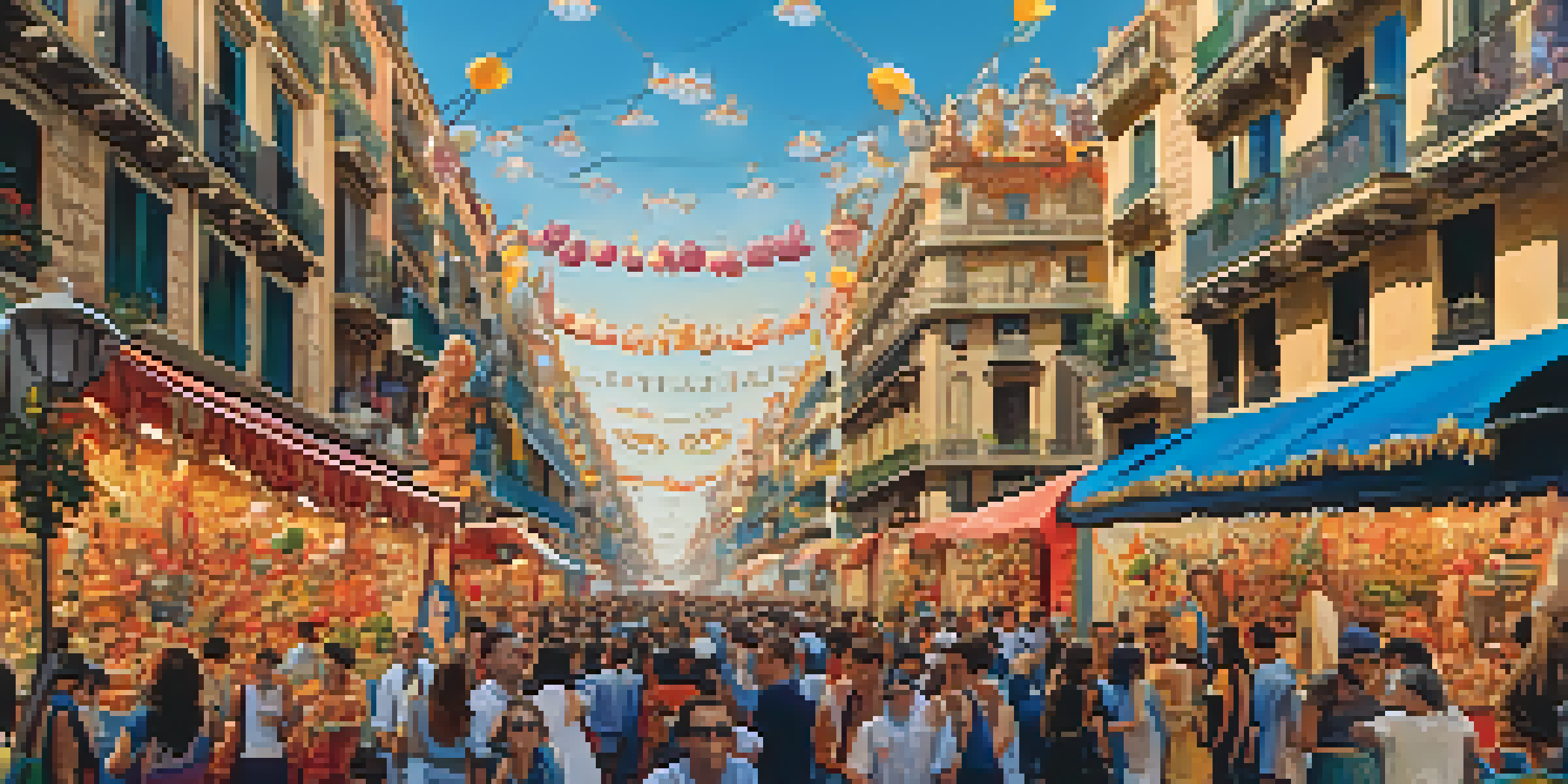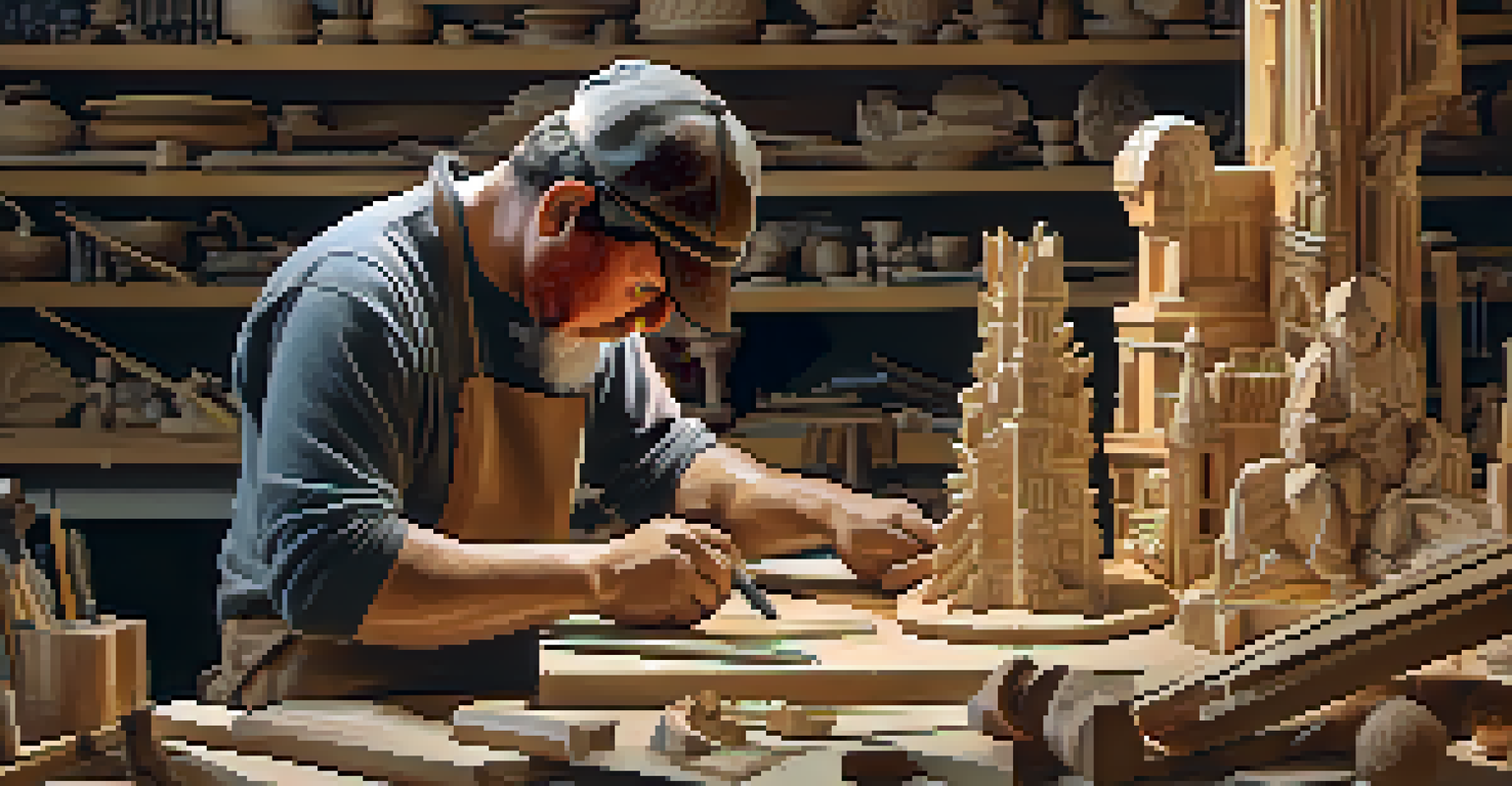Las Fallas: The Art of Fire and Light in Valencia's Streets

The Origins of Las Fallas: A Cultural Legacy
Las Fallas, a dazzling festival in Valencia, has roots that date back to the Middle Ages. Originally, it was a celebration marking the arrival of spring, where carpenters would burn their leftover wood. Over the years, this practice evolved, incorporating artistry, community involvement, and a playful spirit.
Festivals are a way for communities to express their identity and creativity, a celebration of life and culture.
The festival's transformation was influenced by various cultural shifts, including the rise of local artisans who began creating intricate sculptures called 'fallas.' These towering figures often depict satirical scenes, showcasing social and political commentary that resonates with the community's sentiments.
Today, Las Fallas is not just a festival; it is a symbol of Valencia's identity, drawing both locals and tourists who come to witness the fusion of tradition, art, and celebration. The event highlights the city's creativity and pride, making it a unique cultural experience.
The Artistic Process: Crafting the Fallas
Creating a falla is no small feat; it involves a team of skilled artisans who dedicate months to design and construct these impressive sculptures. The process begins with brainstorming ideas, often sparked by current events or local legends, ensuring that each falla tells a story.

Artisans use a variety of materials, including wood, cardboard, and plaster, to bring their visions to life. The attention to detail is astonishing—some fallas can stand over 30 feet tall and are adorned with intricate decorations that capture the imagination.
Las Fallas: A Cultural Celebration
Las Fallas is a vibrant festival in Valencia, rooted in tradition, artistry, and community involvement, symbolizing the city's identity.
Once completed, these stunning works of art become the centerpiece of the festival, inviting admiration and reflection from spectators. The craftsmanship involved showcases the rich artistic heritage of Valencia, making each falla a testament to the dedication and talent of its creators.
The Celebration Begins: Las Fallas Festivities
Las Fallas officially kicks off on March 1st, but the excitement builds long before that. Festivities include parades, music, and traditional costumes, creating an electrifying atmosphere throughout the city. Each neighborhood hosts its own events, fostering a sense of community and friendly competition.
Art is not what you see, but what you make others see.
One of the highlights is the 'Plantà,' when the fallas are officially erected in their designated locations, transforming the streets into a vibrant art gallery. This is followed by a series of events, including fireworks displays, paella contests, and the iconic 'Mascletà,' a daytime fireworks show that fills the air with thrilling sounds and energy.
As night falls, Valencia comes alive with parties and celebrations, where locals and visitors dance and enjoy traditional tapas. The festival is a sensory overload, rich in sights, sounds, and tastes, creating unforgettable memories for everyone involved.
The Grand Finale: Burning of the Fallas
The climax of Las Fallas occurs on March 19th, known as 'La Crema.' This is when the fallas, after days of admiration, are set ablaze in a spectacular display of fire and light. Each falla is ignited in a ceremonial manner, with the largest and most intricate sculptures taking center stage.
As flames engulf the fallas, spectators watch in awe as the artistry is consumed in a fiery blaze. This act symbolizes renewal and the arrival of spring, reminding everyone of the cycle of creation and destruction that art embodies.
Artisan Craftsmanship Shines
The creation of fallas involves skilled artisans who dedicate months to design and build intricate sculptures that captivate audiences.
The burning of the fallas is a poignant moment filled with emotion, as the community comes together to celebrate not just the end of the festival, but the shared experiences and memories created throughout the week. It’s a bittersweet farewell to the artistry and creativity that define Las Fallas.
The Spiritual Side: Honoring Saint Joseph
While Las Fallas is largely a celebration of fire and art, there is also a spiritual dimension tied to Saint Joseph, the patron saint of carpenters. The festival culminates on March 19th, coinciding with the Feast of Saint Joseph, reflecting the deep-rooted traditions of the local community.
During the festivities, a beautiful floral offering takes place, where locals dress in traditional attire and present flowers to a statue of the Virgin Mary. This heartfelt ritual highlights the blend of cultural and religious significance that characterizes Las Fallas.
This connection to Saint Joseph adds depth to the festival, reminding attendees of the importance of community, faith, and heritage. It intertwines the joyous celebrations with a sense of reverence, enriching the overall experience of Las Fallas.
Las Fallas in the Modern Era: A Global Phenomenon
In recent years, Las Fallas has gained international recognition, becoming a UNESCO Intangible Cultural Heritage of Humanity. This acknowledgment has helped promote the festival beyond Spain, attracting visitors from around the globe who are eager to witness its unique charm.
Social media plays a significant role in this expansion, as vibrant images and videos of the fallas capture the attention of potential travelers. The festival's colorful and dynamic nature makes it a popular subject for photography, further enhancing its global reach.
A Global Phenomenon Today
Las Fallas has gained international recognition, attracting visitors worldwide while maintaining its rich cultural heritage and traditions.
As Las Fallas continues to evolve, it remains deeply rooted in Valencia's traditions, balancing modern influences while preserving its cultural heritage. This blend of the old and new ensures that the festival remains relevant and exciting for future generations.
Experiencing Las Fallas: Tips for Visitors
If you're planning to experience Las Fallas, timing is crucial. Arriving early in March allows you to witness the buildup of excitement and events leading up to the main festivities. Be sure to check the schedule, as each day offers unique activities and celebrations worth exploring.
Dress comfortably, as you'll be walking and standing a lot. Don't forget to indulge in local cuisine, especially the iconic paella, which is a staple during the festival. Sampling tapas from street vendors adds to the overall experience, allowing you to savor the flavors of Valencia.

Lastly, immerse yourself in the atmosphere by engaging with locals. They are often eager to share their traditions and stories, making your visit even more memorable. Las Fallas is not just a festival to observe; it's an experience to be a part of, rich in culture and camaraderie.